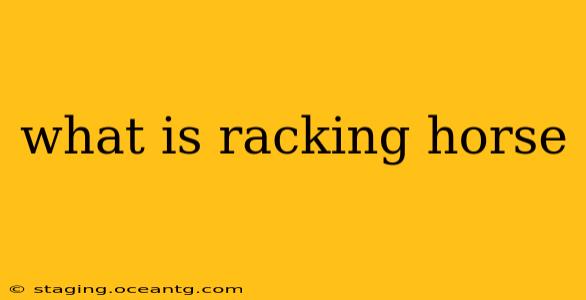Racking is a distinctive, four-beat lateral gait exhibited by certain breeds of horse, most notably the Tennessee Walking Horse. It's a smooth, effortless movement that's both captivating to watch and comfortable for the rider. Unlike other gaits, the racking horse moves with a unique combination of speed and fluidity, making it a prized attribute in equestrian circles. This article delves deep into the characteristics of racking horses, exploring the gait itself, the breeds most associated with it, and common questions surrounding this fascinating equine talent.
What are the characteristics of the racking gait?
The racking gait is characterized by its lateral movement, meaning the legs move in pairs – left front and left hind, followed by right front and right hind. This creates a smooth, almost gliding motion, unlike the more pronounced diagonal movement of a trot or canter. Each foot strikes the ground individually, creating a four-beat rhythm that is often described as musical or rhythmic. The horse's head and neck remain relatively low and steady, contributing to the overall smooth and comfortable ride. The speed of the rack can vary, from a slow, deliberate pace to a surprisingly fast, almost running gait.
What breeds of horses are known for racking?
While the Tennessee Walking Horse is most strongly associated with the racking gait, other breeds can also exhibit this unique movement, although often not as consistently or smoothly. These breeds might display racking as a natural variation within their gait repertoire, or it might be selectively bred for. It's important to note that even within a breed like the Tennessee Walking Horse, the quality and style of racking can vary significantly.
Is racking the same as the running walk?
While both racking and the running walk are smooth, four-beat lateral gaits, there are key differences. The running walk, frequently seen in gaited breeds like the Icelandic horse, has a more pronounced suspension phase—a period where all four feet are briefly off the ground—than the rack. The racking gait usually maintains more contact with the ground, resulting in a smoother, less bouncing ride. The running walk is often faster than a rack, especially at higher speeds.
Is racking a natural gait or a trained gait?
The question of whether racking is natural or trained is complex. While some horses naturally exhibit a gait resembling a rack, the refined and consistent racking seen in performance horses is often the result of careful training and selection. Experienced trainers use specific techniques to encourage and refine the natural tendencies of the horse, often emphasizing the lateral movement and smooth, four-beat rhythm. However, the underlying predisposition to this gait is often genetically influenced.
How is a racking horse different from a trotting horse?
The most significant difference lies in the movement pattern of the legs. A trotting horse moves in a diagonal sequence – left front and right hind, then right front and left hind. This creates a more pronounced bouncing motion, especially at faster speeds. A racking horse, on the other hand, exhibits a lateral gait, resulting in a smoother and more comfortable ride. The rhythm also differs, with the trot having a two-beat rhythm, whereas the rack has a distinctive four-beat rhythm.
Is it difficult to ride a racking horse?
For experienced riders, the racking gait can be remarkably comfortable and even therapeutic. However, for novice riders, it may initially feel somewhat unusual or disorienting, compared to the more familiar gaits of walking and trotting. The smooth, lateral movement requires a degree of balance and coordination that may take some getting used to. However, with proper instruction and practice, most riders find that they quickly adapt to the unique motion of a racking horse.
What are the advantages of riding a racking horse?
Many riders appreciate the comfort and smoothness of the racking gait. It's often cited as being particularly beneficial for riders with back problems or other physical limitations, as it minimizes jarring and bouncing. Additionally, the rhythmic, four-beat gait can be quite meditative and enjoyable. The steady pace and smooth movement also make racking horses suitable for trail riding and other leisurely activities.
This deep dive into the world of racking horses highlights the unique characteristics of this gait and the breeds that excel in it. While some horses exhibit natural tendencies towards racking, the refined elegance of the gait is often the result of careful training and selective breeding. Understanding the differences between racking and other gaits, like the running walk or trot, provides a richer appreciation for the nuances of equine movement.
